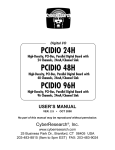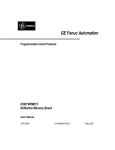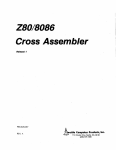Download ADLINK Technology NuDAQ-2500 Series User`s guide
Transcript
NuIPC / NuDAQ 743X Series 64-CH Isolated Digital I/O Board User’s Guide Copyright 2002 ADLINK Technology Inc. All Rights Reserved. Manual Rev. 3.34: October 22, 2002 Part NO: 50-11108-202 The information in this document is subject to change without prior notice in order to improve reliability, design and function and does not represent a commitment on the part of the manufacturer. In no event will the manufacturer be liable for direct, indirect, special, incidental, or consequential damages arising out of the use or inability to use the product or documentation, even if advised of the possibility of such damages. This document contains proprietary information protected by copyright. All rights are reserved. No part of this manual may be reproduced by any mechanical, electronic, or other means in any form without prior written permission of the manufacturer. Trademarks NuDAQ , NuIPC , DAQBench are registered trademarks of ADLINK Technology Inc. Other product names mentioned herein are used for identification purposes only and may be trademarks and/or registered trademarks of their respective companies. Getting service from ADLINK • Customer Satisfaction is the most important priority for ADLINK Tech Inc. If you need any help or service, please contact us. ADLINK Technology Inc. Web Site http://www.adlinktech.com Sales & Service [email protected] NuDAQ + USBDAQ [email protected] Automation [email protected] NuIPC [email protected] NuPRO / EBC [email protected] TEL +886-2-82265877 FAX Address 9F, No. 166, Jian Yi Road, Chungho City, Taipei, 235 Taiwan. Technical Support • +886-2-82265717 Please email or FAX us of your detailed information for a prompt, satisfactory and constant service. Detailed Company Information Company/Organization Contact Person E-mail Address Address Country TEL FAX Web Site Questions Product Model Environment to Use Detail Description Suggestions to ADLINK OS: Computer Brand: M/B: CPU: Chipset: BIOS: Video Card: Network Interface Card: Other: Table of Contents Tables and Figures..................................................................iii Introduction ............................................................................... 1 1.1 1.2 1.3 1.4 Features .............................................................................. 2 Applications ......................................................................... 3 Specifications ...................................................................... 3 Supporting Software............................................................. 5 1.4.1 1.4.2 1.4.3 1.4.4 1.4.5 1.4.6 1.4.7 1.4.8 Programming Library .................................................................. 5 ® PCIS-LVIEW: LabVIEW Driver................................................ 6 PCIS-VEE: HP-VEE Driver.......................................................... 6 DAQBenchTM: ActiveX Controls ................................................. 6 PCIS-DDE: DDE Server and InTouchTM ................................. 7 PCIS-ISG: ISaGRAFTM driver..................................................... 7 PCIS-ICL: InControlTM Driver..................................................... 7 PCIS-OPC: OPC Server .............................................................. 7 Getting Started ......................................................................... 8 2.1 2.2 2.3 What You Have.................................................................... 8 Unpacking ........................................................................... 9 PCB Layout ......................................................................... 9 2.3.1 2.3.2 2.3.3 PCI-743X PCB Layout................................................................. 9 cPCI-743X PCB Layout 10 cPCI-743XR PCB Layout 10 2.4 2.5 2.6 Hardware Installation Outline .............................................. 11 Device Installation for Windows Systems............................. 12 Connector Pin Assignment for PCI-7432, cPCI-7432, cPCI7432R ............................................................................. 13 2.7 Connector Pin Assignment of cPCI-7432RP ........................ 14 2.8 Connector Pin Assignment of cPCI-7433/R & PCI-7433 ....... 15 2.9 Connector Pin Assignment of PCI-7434............................... 16 2.10 Connector Pin Assignment of cPCI-7434R........................... 17 2.11 Connector Pin Assignment of cPCI-7434RP ........................ 18 2.11 Jumpers Setting ................................................................. 19 Table of Contents • i Registers ..................................................................................21 3.1 3.2 3.3 3.4 PCI PnP Registers ............................................................. 21 I/O Address Map ................................................................ 22 Digital Input Register .......................................................... 23 Digital Output Register ....................................................... 24 Operation Theory ...................................................................25 4.1 4.2 Isolated Digital Input Channels............................................ 25 Isolated Digital Output Channels ......................................... 26 C/C++ Libraries.......................................................................27 5.1 5.2 Libraries Installation ........................................................... 27 Programming Guide ........................................................... 28 5.2.1 5.2.2 5.3 5.4 5.5 5.6 5.7 5.8 5.9 5.10 5.11 5.12 Naming Convention.....................................................................28 Data Types...................................................................................28 Running the Testing Utility.................................................. 29 Initial ............................................................................. 29 Digital Input Relative Functions ........................................... 31 Digital Output Relative Functions ........................................ 32 Interrupt Source Control ..................................................... 33 Get Interrupt Status ............................................................ 34 Interrupt Enable ................................................................. 35 Interrupt Disable ................................................................ 36 LED Control Function......................................................... 37 Get Slot Number ................................................................ 38 Warranty Policy ......................................................................39 ii • Table of Contents Tables and Figures Tables Table 1. Table 2. Table 3. Table 4. Table 5. Table 6. Table 7. Table 8. Features between different 743X Models ........................ 2 Optical Isolated Input Channel Specifications .................. 3 Optical Isolated Output Channel Specifications ................ 4 PCI-7433 jumper setting table ...................................... 19 I/O Address Map of c/PCI-7432/33/34 ........................... 22 IDI_N: Isolated Digital Input CH N................................. 23 IDO_N: Isolated Digital Output CH N ............................ 24 Function Data Types .................................................... 28 Figures Figure 1: Figure 2: Figure 3: Figure 4: Figure 5: Figure 6: Figure 7: Figure 8: Figure 9: Figure 10: Figure 11: Figure 12: Figure 13: PCI-743X PCB Layout ................................................... 9 cPCI-743X PCB Layout................................................ 10 cPCI-743XR PCB Layout ............................................. 10 Pin Assignment of 7432 CN1 Connector ....................... 13 Pin Assignment of cPCI-7432RP CN1 Connector .......... 14 Pin Assignment of 7433 CN1 Connector ....................... 15 Pin Assignment of PCI-7434 CN1Connector ................. 16 Pin Assignment of cPCI-7434R CN1 Connector ............ 17 Pin Assignment of cPCI-7434RP CN1 Connector .......... 18 Simplified digital input circuit diagram............................ 19 PCI-7433 (rev. B2) Jumper Locations ........................... 20 Isolated input connection ............................................. 25 Common Ground Connection for cPCI-7434R and cPCI-7432R ................................................................ 26 Figure 14: Common Power Connection for cPCI-7434R/P and cPCI-7432R/P ............................................................. 26 Tables and Figures • iii How to Use This Guide This manual is designed to help you use the 743X series products. It describes how to modify and control various functions of the 743X card to meet the requirements of your application. It is divided into four chapters: Chapter 1, “Introduction”, gives an overview of the product features, applications, and specifications. Chapter 2, “Getting Started”, describes how to install the board. The PCB layout, connector specifications, and installation notes are also described. Chapter 3, “Registers”, describes the details of the registers and its structure. This information is important for programmers who want to control the hardware with low-level programming Chapter 4, “C/C++ Library”, describes the functions in the DOS C/C++ Library and Windows 95 DLL. iv • How to Use This Guide 1 Introduction The 743X series products are 64-CH high-density isolated digital input and/or output cards. The 743X series products include the following cards and are available in different form factors. The following items are PCI bus products: • PCI-7432: Isolated 32-CH DI and 32-CH DO card • • PCI-7433: Isolated 64-CH DI card PCI-7434: Isolated 64-CH DO card The following items are 3U CompactPCI products: • • cPCI-7432 : Isolated 32-CH DI and 32-CH DO card cPCI-7433 : Isolated 64-CH DI card • cPCI-7434 : Isolated 64-CH DO card with common ground configuration cPCI-7434P: Isolated 64-CH DO card with common power configuration • The following items are for 3U CompactPCI with rear I/O: • • cPCI-7432R : Isolated 32-CH DI and 32-CH DO card cPCI-7432RP : Isolated 32-CH DI and 32-CH DO card with common power configuration • • cPCI-7433R : Isolated 64-CH DI card cPCI-7434R : Isolated 64-CH DO card with common ground configuration • cPCI-7434RP: Isolated 64-CH DO card with common power configuration Introduction • 1 The above I/O cards are isolated up-to 5000 Vdc (excluding cables) for channel-to-computer isolation. It protects your computer against damage caused by accidental contact with high external voltage and eliminates troublesome ground loops. The 743X series products use PCI-9050 PCI controller to interface the board to the PCI bus. The PCI-9050 fully implements the PCI local bus specification Rev 2.1. All bus relative configurations, such as base memory and interrupt assignment, are automatically controlled by BIOS software. 1.1 Features The PCI-743X Isolated D/I cards provide the following advanced features: PCI bus PCI-7432 PCI-7433 PCI-7434 3U CompactPCI cPCI-7432 cPCI-7433 cPCI-7434 cPCI-7434P 3U CompactPCI with Rear I/O cPCI-7434R cPCI-7432R cPCI-7433R cPCI-7432RP cPCI-7434RP 32 Isolated Digital Input / Output Channels √ -- -- 64 Isolated Digital Input Channels -- √ -- 64 Isolated Digital Output Channels -- -- √ High output driving capability √ -- √ 500mA sink current on isolated output channels √ √ -1 5000 Vrms high voltage isolation √* Up to 24V voltage protection for isolated input √ √ -- External interrupt signal on DI channels √ √ -- Dual interrupt trigger √ √ -- 100-pin SCSI-II connector √ √ √ Table 1. *1: √* 1 √ Features between different 743X Models For PCI-7433, cPCI-7433R and cPCI-7432R/P, the isolation voltage is up to 2500 Vrms. 2 • Introduction 1.2 Applications • • Laboratory and Industrial automation Watchdog timer • Event counter • • Frequency counter and generator Low level pulse generator • Time delay 1.3 Specifications ♦ Optical Isolated Input Channel Number of Channel PCI-7432 cPCI-7432 cPCI-7432R/P PCI-7433 cPCI-7433 cPCI-7433R 32 DI 64 DI Input Voltage 0 – 24V dc logic H: 5~24V logic L: 0~1.5V Input Resistance 2.4KΩ@0.5W (2.4 KΩ @1W for PCI-7433) Isolated Voltage 5000 Vrms (2500 Vrms for PCI-7433, cPCI-7433R, cPCI7432R/P) Throughput 10K Hz (0.1 ms) Interrupt Sources Digital input channel 0 and channel 1 Power Consumption Table 2. +5V @ 530 mA typical +5V @ 500 mA typical Optical Isolated Input Channel Specifications Introduction • 3 ♦ Optical Isolated Output Channel PCI-7432 cPCI-7432 cPCI-7432R/P Number of Channel Output Type PCI-7434 cPCI-7434/P cPCI-7434R/P 32 DO 64 DO Darlington transistor with ground/common power Output Voltage 5VDC min, 35VDC maximum Output Device ULN2803A (common ground) TD62783 (common power) l Sink Current l l common Max. 500mA/ch if only one of the ULN2083A transistor is ON 500mA/ch if all of the ULN2803A transistors are ON @ 20% duty (Tamb = 50? ) Max. 2.25W per ULN2803A device Isolation Voltage 5000 Vrms (2500 Vrms for cPCI-7432R/P) Throughput 10K Hz (0.1 ms) On Board Isolated +5V Output Power 200mA 150mA Power Consumption +5V @ 530 mA typical +5V @ 560 mA typical Table 3. 4 • Introduction Optical Isolated Output Channel Specifications ♦ General Specifications Connector: 100-pin SCSI-II connector Operating temperature: 0°C ~ 60°C Storage temperature: -20°C ~ 80°C Humidity: 5 ~ 95%, non-condensing Dimension: • PCI-7432/33/34: Compact size only 106mm(H) X 173mm(L) • • cPCI-7432/33/34: Standard 3U CompactPCI form factor cPCI-7432R/33R/34R: Standard 3U CompactPCI form factor with rear I/O 1.4 Supporting Software ADLINK provides versatile software drivers and packages for users’ different approach to building a system. We not only provide programming libraries such as DLL for many Windows systems, but also provide drivers for many ® TM TM other software package such as LabVIEW , HP VEE , DASYLab , TM TM TM InTouch , InControl , ISaGRAF , and so on. All software options are included in the ADLINK CD. Non-free software drivers are protected with licensing codes. Without the software code, you can install and run the demo version for two hours for trial/demonstration purposes. Please contact ADLINK dealers to purchase the formal license. 1.4.1 Programming Library For customers who are writing their own programs, we provide function libraries for many different operating systems, including: • DOS Library: Borland C/C++ and Microsoft C++, the functions descriptions are included in this user’s guide. • Windows 95 DLL: For VB, VC++, Delphi, BC5, the functions descriptions are included in this user’s guide. Introduction • 5 • PCIS-DASK: Includes device drivers and DLL for Windows 98, Windows NT and Windows 2000. DLL is binary compatible across Windows 98, Windows NT and Windows 2000. This means a ll applications developed with PCIS-DASK are compatible across Windows 98, Windows NT and Windows 2000. The developing environment can be VB, VC++, Delphi, BC5, or any Windows programming language that allows calls to a DLL. The user’s guide and function reference manual of PCIS-DASK are in the CD. Please refer to the PDF manual files under \\Manual_PDF\Software\PCISDASK The above software drivers are shipped with the board. Please refer to the “Software Installation Guide” for installation procedures. 1.4.2 ® PCIS-LVIEW: LabVIEW Driver PCIS-LVIEW contains the VIs, which are used to interface with NI’s LabVIEW® software package. The PCIS-LVIEW supports Windows 95/98/NT/2000. The LabVIEW® drivers is shipped free with the board. You can install and use them without a license. For more information about PCIS-LVIEW, please refer to the user’s guide in the CD. (\\Manual_PDF\Software\PCIS-LVIEW) 1.4.3 PCIS-VEE: HP-VEE Driver The PCIS-VEE includes user objects, which are used to interface with the HP VEE software package. PCIS-VEE supports Windows 95/98/NT. The HP-VEE drivers are shipped free with the board. For more information about PCIS-VEE, please refer to the user’s guide in the CD. (\\Manual_PDF\Software\PCIS-VEE) 1.4.4 TM DAQBench : ActiveX Controls We suggest customers who are familiar with ActiveX controls and VB/VC++ programming use the DAQBenchTM ActiveX Control components library for developing applications. The DAQBenchTM is designed under Windows NT/98. For more information about DAQBench, please refer to the user’s guide in the CD. (\\Manual_PDF\Software\DAQBench\DAQBench Manual.PDF) 6 • Introduction 1.4.5 TM PCIS-DDE: DDE Server and InTouch DDE stands for Dynamic Data Exchange. The PCIS-DDE includes the PCI cards’ DDE server. The PCIS-DDE server is included in the ADLINK CD. It needs a license. The DDE server can be used in conjunction with any DDE client under Windows NT. 1.4.6 PCIS-ISG: ISaGRAF TM driver The ISaGRAF WorkBench is an IEC1131-3 SoftPLC control program development environment. The PCIS-ISG includes ADLINK product drivers for ISaGRAF under Windows NT environment. The PCIS-ISG is included in the ADLINK CD. A license is needed to use the drivers. 1.4.7 TM PCIS-ICL: InControl Driver PCIS-ICL is the InControl driver, which supports Windows NT. The PCISICL is included in the ADLINK CD. A license is needed to use the drivers. 1.4.8 PCIS-OPC: OPC Server PCIS-OPC is an OPC Server, which can link with OPC clients. There are several software packages on the market, which can provide the OPC clients. The PCIS-OPC supports Windows NT and requires a license to operate. Introduction • 7 2 Getting Started This chapter describes how to install and setup the 743X Series cards. The contents in the package and unpacking information that you should be aware of are outlined first. 2.1 What You Have In addition to the User’s Manual, the package should include the following items: • 743X Board • • ADLINK CD Software Installation Guide • Rear I/O transition board (DB-100RU) for cPCI-743XR rear I/O version only If any of these items are missing or damaged, contact ADLINK or the dealer from whom you purchased the product. Save the shipping materials and carton in case you want to ship or store the product in the future. 8 • Getting Started 2.2 Unpacking The PCI-7432/33/34 card contains electro-static sensitive components that can be easily be damaged by static electricity. Therefore, the card should be handled on a grounded anti-static mat. The operator should be wearing an anti-static wristband, grounded at the same point as the anti-static mat. Inspect the card module carton for obvious damages. Shipping and handling may cause damage to your module. Be sure there are no shipping and handling damages on the modules carton before continuing. After opening the card module carton, extract the system module and place it only on a grounded anti-static surface with component side up. Again, inspect the module for damages. Press down on all the socketed IC's to make sure that they are properly seated. Do this only with the module place on a firm flat surface Note: DO NOT ATTEMPT TO INSTALL A DAMAGED BOARD IN THE COMPUTER. You are now ready to install your card. 2.3 PCB Layout 2.3.1 PCI-743X PCB Layout CN1 is the I/O interface and is a 100-pin SCSI-type connector. Figure 1: PCI-743X PCB Layout Getting Started • 9 2.3.2 cPCI-743X PCB Layout The CN1 is the I/O interface and is a 100-pin SCSI-type connector. Figure 2: 2.3.3 cPCI-743X PCB Layout cPCI-743XR PCB Layout CN1 is the I/O interface and is a 100-pin SCSI-type connector. J2 is used for rear I/O signaling. There are no connectors on the main board. Figure 3: 10 • Getting Started cPCI-743XR PCB Layout 2.4 Hardware Installation Outline PCI configuration The PCI cards (or CompactPCI cards) are equipped with plug and play PCI controllers, it can request base addresses and interrupts according to the PCI standard. The system BIOS will assign the system resources based on the PCI cards’ configuration registers and system parameters (which are set by the system BIOS). Interrupt assignment and memory usage (I/O port locations) can only be assigned by the system BIOS. These system resource assignments are done on a board-by-board basis. It is not suggested to assign the system resource by any other methods. PCI slot selection The PCI card can be inserted into any PCI slot without any configuration of the system resources. The CompactPCI card can also be inserted into any CompactPCI I/O slot. Installation Procedures 1. 2. 3. 4. 5. 6. 7. 8. Turn off your computer Turn off all accessories (printer, modem, monitor, etc.) connected to your computer. Remove the cover from your computer. Setup jumpers on the PCI or CompactPCI card. Select a 32-bit PCI slot. PCI slot are shorter than ISA or EISA slots, and are usually white or ivory. Before handling the PCI cards, discharge any static buildup on your body by touching the metal case of the computer. Hold the edge and do not touch the components. Position the board into the PCI slot you selected. Secure the card in place at the rear panel of the system. Getting Started • 11 For cPCI-743X products (with and without rear I/O) 1. Read through this manual, and setup the jumper according to your application needs. 2. Turn off your computer and all accessories (printer, modem, monitor, etc.) connected to the computer. 3. Remove the cover from the slot of your cPCI computer. 4. Select a 32-bit cPCI expansion slot on the back plane for cPCI-743X card. 5. Before handling the cPCI-743X card, discharge any static buildup from your body by touching the metal casing of the computer. Hold the edge and do not touch the components. 6. Position the board into the cPCI slot you selected. 7. Secure the card on the back plane by using screws removed from the slot. CAUTION!! Don’t put cPCI-743XR (rear I/O) cards into the cPCI back plane of other manufacturers because the rear I/O definition might be different, and permanent damage could happen. 2.5 Device Installation for Windows Systems Once Windows 95/98/2000 has started, the Plug and Play functions of the Windows system will find and locate the new NuDAQ/NuIPC card. If this is the first time a NuDAQ/NuIPC card is installed in your Windows system , you will be prompted to input the device information source. Please refer to the “Software Installation Guide” for installation procedures of the device drivers. 12 • Getting Started 2.6 Connector Pin Assignment for PCI-7432, cPCI-7432, cPCI-7432R The pin assignment of the 100-pin SCSI-II connector for the 7432 Series is shown in figure 4 below. (1) (2) (3) (48) (49) (50) (51) (52) (53) (98) (99) (100) Figure 4: (1) IDI_0 (26) IDO_0 (51) IDI_8 (76) IDO_8 (2) IDI_1 (3) IDI_2 (4) IDI_3 (27) IDO_1 (28) IDO_2 (29) IDO_3 (52) IDI_9 (53) IDI_10 (54) IDI_11 (77) IDO_9 (78) IDO_10 (79) IDO_11 (5) IDI_4 (6) IDI_5 (30) IDO_4 (31) IDO_5 (55) IDI_12 (56) IDI_13 (80) IDO_12 (81) IDO_13 (7) IDI_6 (8) IDI_7 (9) COM1 (32) IDO_6 (33) IDO_7 (34) VDD1 (57) IDI_14 (58) IDI_15 (59) COM2 (82) IDO_14 (83) IDO_15 (84) VDD2 (10) COM1 (11) COM1 (35) IGND (36) IGND (60) COM2 (61) COM2 (85) IGND (86) IGND (12) COM1 (13) IDI_16 (14) IDI_17 (37) IGND (38) IDO_16 (39) IDO_17 (62) COM2 (63) IDI_24 (64) IDI_25 (87) IGND (88) IDO_24 (89) IDO_25 (15) IDI_18 (16) IDI_19 (40) IDO_18 (41) IDO_19 (65) IDI_26 (66) IDI_27 (90) IDO_26 (91) IDO_27 (17) IDI_20 (18) IDI_21 (19) IDI_22 (42) IDO_20 (43) IDO_21 (44) IDO_22 (67) IDI_28 (68) IDI_29 (69) IDI_30 (92) IDO_28 (93) IDO_29 (94) IDO_30 (20) IDI_23 (21) COM3 (45) IDO_23 (46) VDD3 (70) IDI_31 (71) COM4 (95) IDO_31 (96) VDD4 (22) COM3 (23) COM3 (24) COM3 (47) IGND (48) IGND (49) IGND (72) COM4 (73) COM4 (74) COM4 (97) IGND (98) IGND (99) IGND (25) NC (50) V5V (75) NC (100) V5V Pin Assignment of 7432 CN1 Connector Legend: IDI_n: Isolated digital input channel n IDO_n: Isolated digital output channel n VDDm: Common pin for output channel group m (VDD1 is common pin for isolated output channel 0~7, VDD2 is common pin for isolated output channel 8~15, and so on). IGND: Ground return path for isolated output channels COMm: Common junction for isolated input channel group m (COM1 is common junction for input channel 0~7, COM2 is common junction for input channel 8~15, and so on). V5V: Onboard un-regulated 5V power supply output Getting Started • 13 2.7 Connector Pin Assignment of cPCI-7432RP The cPCI-7432RP’s pin assignment is shown in Figure 5. (1) (2) (3) (51) (52) (53) (48) (49) (50) (98) (99) (100) Figure 5: (1) IDI_0 (2) IDI_1 (3) IDI_2 (26) IDO_0 (27) IDO_1 (28) IDO_2 (51) IDI_8 (52) IDI_9 (53) IDI_10 (76) IDO_8 (77) IDO_9 (78) IDO_10 (4) IDI_3 (5) IDI_4 (29) IDO_3 (30) IDO_4 (54) IDI_11 (55) IDI_12 (79) IDO_11 (80) IDO_12 (6) IDI_5 (7) IDI_6 (8) IDI_7 (31) IDO_5 (32) IDO_6 (33) IDO_7 (56) IDI_13 (57) IDI_14 (58) IDI_15 (81) IDO_13 (82) IDO_14 (83) IDO_15 (9) COM1 (10) COM1 (34) IGND (35) VDD1 (59) COM2 (60) COM2 (84) IGND (85) VDD2 (11) COM1 (12) COM1 (13) IDI_16 (36) VDD1 (37) VDD1 (38) IDO_16 (61) COM2 (62) COM2 (63) IDI_24 (86) VDD2 (87) VDD2 (88) IDO_24 (14) IDI_17 (15) IDI_18 (39) IDO_17 (40) IDO_18 (64) IDI_25 (65) IDI_26 (89) IDO_25 (90) IDO_26 (16) IDI_19 (17) IDI_20 (18) IDI_21 (41) IDO_19 (42) IDO_20 (43) IDO_21 (66) IDI_27 (67) IDI_28 (68) IDI_29 (91) IDO_27 (92) IDO_28 (93) IDO_29 (19) IDI_22 (20) IDI_23 (44) IDO_22 (45) IDO_23 (69) IDI_30 (70) IDI_31 (94) IDO_30 (95) IDO_31 (21) COM3 (22) COM3 (23) COM3 (46) IGND (47) VDD3 (48) VDD3 (71) COM4 (72) COM4 (73) COM4 (96) IGND (97) VDD4 (98) VDD4 (24) COM3 (25) NC (49) VDD3 (50) V5V (74) COM4 (75) NC (99) VDD4 (100) V5V Pin Assignment of cPCI-7432RP CN1 Connector Legend: IDI_n: Isolated digital input channel n. IDO_n: Isolated digital output channel n. VDDm: Common pin for output channel group m, m=1 for output channel 0~7, m=2 for output channel 8~15, m=3 for output channel 16~23, m=4 for output channel 24~31. IGND: Ground return path for isolated output channels. COMm: Common junction for isolated input channel group m, m=1 for input channel 0~7, m=2 for input channel 8~15, m=3 for input channel 16~23, m=4 for input channel 24~31. V5V: Onboard un-regulated 5V power supply output 14 • Getting Started 2.8 Connector Pin Assignment of cPCI-7433/R & PCI-7433 The pin assignment of the 100-pin SCSI-II connector for the 7433 Series is shown in figure 6 below. (1) (2) (3) (48) (49) (50) (51) (52) (53) (98) (99) (100) Figure 6: (1) IDI_0 (26) IDI_32 (51) IDI_8 (76) IDI_40 (2) IDI_1 (3) IDI_2 (27) IDI_33 (28) IDI_34 (52) IDI_9 (53) IDI_10 (77) IDI_41 (78) IDI_42 (4) IDI_3 (5) IDI_4 (6) IDI_5 (29) IDI_35 (30) IDI_36 (31) IDI_37 (54) IDI_11 (55) IDI_12 (56) IDI_13 (79) IDI_43 (80) IDI_44 (81) IDI_45 (7) IDI_6 (8) IDI_7 (32) IDI_38 (33) IDI_39 (57) IDI_14 (58) IDI_15 (82) IDI_46 (83) IDI_47 (9) COM1 (10) COM1 (11) COM1 (34) COM5 (35) COM5 (36) COM5 (59) COM2 (60) COM2 (61) COM2 (84) COM6 (85) COM6 (86) COM6 (12) COM1 (13) IDI_16 (37) COM5 (38) IDI_48 (62) COM2 (63) IDI_24 (87) COM6 (88) IDI_56 (14) IDI_17 (15) IDI_18 (16) IDI_19 (39) IDI_49 (40) IDI_50 (41) IDI_51 (64) IDI_25 (65) IDI_26 (66) IDI_27 (89) IDI_57 (90) IDI_58 (91) IDI_59 (17) IDI_20 (18) IDI_21 (42) IDI_52 (43) IDI_53 (67) IDI_28 (68) IDI_29 (92) IDI_60 (93) IDI_61 (19) IDI_22 (20) IDI_23 (21) COM3 (44) IDI_54 (45) IDI_55 (46) COM7 (69) IDI_30 (70) IDI_31 (71) COM4 (94) IDI_62 (95) IDI_63 (96) COM8 (22) COM3 (23) COM3 (47) COM7 (48) COM7 (72) COM4 (73) COM4 (97) COM8 (98) COM8 (24) COM3 (25) NC (49) COM7 (50) NC (74) COM4 (75) NC (99) COM8 (100) NC Pin Assignment of 7433 CN1 Connector Legend: IDI_n: Isolated digital input channel n. COMm: Common junction for isolated input channel group m, (COM1 is common junction for input channel 0~7, COM2 is common junction for input channel 8~15, COM3 is common junction of input channel 16~23, and so on.) Getting Started • 15 2.9 Connector Pin Assignment of PCI-7434 The pin assignment of the 100-pin SCSI-II connector for the PCI-7434 Series is shown in figure 7 below. (1) (2) (3) (51) (52) (53) (48) (49) (50) (98) (99) (100) Figure 7: (1) IDO_0 (26) IDO_32 (51) IDO_8 (76) IDO_40 (2) IDO_1 (3) IDO_2 (27) IDO_33 (28) IDO_34 (52) IDO_9 (53) IDO_10 (77) IDO_41 (78) IDO_42 (4) IDO_3 (5) IDO_4 (6) IDO_5 (29) IDO_35 (30) IDO_36 (31) IDO_37 (54) IDO_11 (55) IDO_12 (56) IDO_13 (79) IDO_43 (80) IDO_44 (81) IDO_45 (7) IDO_6 (8) IDO_7 (32) IDO_38 (33) IDO_39 (57) IDO_14 (58) IDO_15 (82) IDO_46 (83) IDO_47 (9) VDD1 (10) IGND (11) IGND (34) VDD5 (35) IGND (36) IGND (59) VDD2 (60) IGND (61) IGND (84) VDD6 (85) IGND (86) IGND (12) IGND (13) IDO_16 (37) IGND (38) IDO_48 (62) IGND (63) IDO_24 (87) IGND (88) IDO_56 (14) IDO_17 (15) IDO_18 (16) IDO_19 (39) IDO_49 (40) IDO_50 (41) IDO_51 (64) IDO_25 (65) IDO_26 (66) IDO_27 (89) IDO_57 (90) IDO_58 (91) IDO_59 (17) IDO_20 (18) IDO_21 (42) IDO_52 (43) IDO_53 (67) IDO_28 (68) IDO_29 (92) IDO_60 (93) IDO_61 (19) IDO_22 (20) IDO_23 (21) VDD3 (44) IDO_54 (45) IDO_55 (46) VDD7 (69) IDO_30 (70) IDO_31 (71) VDD4 (94) IDO_62 (95) IDO_63 (96) VDD8 (22) IGND (23) IGND (47) IGND (48) IGND (72) IGND (73) IGND (97) IGND (98) IGND (24) IGND (25) NC (49) IGND (50) V5V (74) IGND (75) NC (99) IGND (100) V5V Pin Assignment of PCI-7434 CN1Connector Legend: IDO_n: Isolated digital output channel n. VDDm: Common pin for isolated output channel group m, (VDD1 is the common pin for isolated output channel 0~7, VDD2 is for channel 8~15, VDD3 is for channel 16~23, VDD4 is for channel 24~31, VDD5 is for channel 32~39, VDD6 is for channel 40~47, VDD7 is for channel 48~55, and VDD8 is for channel 56~63). IGND: Ground return path for isolated output channels. V5V: Onboard un-regulated 5V power supply output 16 • Getting Started 2.10 Connector Pin Assignment of cPCI-7434R cPCI-7434R’s pin assignment is shown in Figure 8. (1) (2) (3) (51) (52) (53) (48) (49) (50) (98) (99) (100) Figure 8: (1) IDO_0 (2) IDO_1 (3) IDO_2 (26) IDO_32 (27) IDO_33 (28) IDO_34 (51) IDO_8 (52) IDO_9 (53) IDO_10 (76) IDO_40 (77) IDO_41 (78) IDO_42 (4) IDO_3 (5) IDO_4 (29) IDO_35 (30) IDO_36 (54) IDO_11 (55) IDO_12 (79) IDO_43 (80) IDO_44 (6) IDO_5 (7) IDO_6 (8) IDO_7 (31) IDO_37 (32) IDO_38 (33) IDO_39 (56) IDO_13 (57) IDO_14 (58) IDO_15 (81) IDO_45 (82) IDO_46 (83) IDO_47 (9) VDD (10) IGND (34) VDD (35) IGND (59) VDD (60) IGND (84) VDD (85) IGND (11) IGND (12) IGND (13) IDO_16 (36) IGND (37) IGND (38) IDO_48 (61) IGND (62) IGND (63) IDO_24 (86) IGND (87) IGND (88) IDO_56 (14) IDO_17 (15) IDO_18 (39) IDO_49 (40) IDO_50 (64) IDO_25 (65) IDO_26 (89) IDO_57 (90) IDO_58 (16) IDO_19 (17) IDO_20 (18) IDO_21 (41) IDO_51 (42) IDO_52 (43) IDO_53 (66) IDO_27 (67) IDO_28 (68) IDO_29 (91) IDO_59 (92) IDO_60 (93) IDO_61 (19) IDO_22 (20) IDO_23 (44) IDO_54 (45) IDO_55 (69) IDO_30 (70) IDO_31 (94) IDO_62 (95) IDO_63 (21) VDD (22) IGND (23) IGND (46) VDD (47) IGND (48) IGND (71) VDD (72) IGND (73) IGND (96) VDD (97) IGND (98) IGND (24) IGND (25) NC (49) IGND (50) V5V (74) IGND (75) NC (99) IGND (100) V5V Pin Assignment of cPCI-7434R CN1 Connector Legend: IDO_n: Isolated digital output channel n. VDDm: Common pin for isolated output channel group m (Note: All outputs share the same power supply). IGND: Ground return path for isolated output channels. V5V: Onboard un-regulated 5V power supply output Getting Started • 17 2.11 Connector Pin Assignment of cPCI-7434RP cPCI-7434RP’s pin assignment is shown in Figure 9. (1) (2) (3) (51) (52) (53) (48) (49) (50) (98) (99) (100) Figure 9: (1) IDO_0 (2) IDO_1 (3) IDO_2 (26) IDO_32 (27) IDO_33 (28) IDO_34 (51) IDO_8 (52) IDO_9 (53) IDO_10 (76) IDO_40 (77) IDO_41 (78) IDO_42 (4) IDO_3 (5) IDO_4 (29) IDO_35 (30) IDO_36 (54) IDO_11 (55) IDO_12 (79) IDO_43 (80) IDO_44 (6) IDO_5 (7) IDO_6 (8) IDO_7 (31) IDO_37 (32) IDO_38 (33) IDO_39 (56) IDO_13 (57) IDO_14 (58) IDO_15 (81) IDO_45 (82) IDO_46 (83) IDO_47 (9) IGND (10) VDD (34) IGND (35) VDD (59) IGND (60) VDD (84) IGND (85) VDD (11) VDD (12) VDD (13) IDO_16 (36) VDD (37) VDD (38) IDO_48 (61) VDD (62) VDD (63) IDO_24 (86) VDD (87) VDD (88) IDO_56 (14) IDO_17 (15) IDO_18 (39) IDO_49 (40) IDO_50 (64) IDO_25 (65) IDO_26 (89) IDO_57 (90) IDO_58 (16) IDO_19 (17) IDO_20 (18) IDO_21 (41) IDO_51 (42) IDO_52 (43) IDO_53 (66) IDO_27 (67) IDO_28 (68) IDO_29 (91) IDO_59 (92) IDO_60 (93) IDO_61 (19) IDO_22 (20) IDO_23 (44) IDO_54 (45) IDO_55 (69) IDO_30 (70) IDO_31 (94) IDO_62 (95) IDO_63 (21) IGND (22) VDD (23) VDD (46) IGND (47) VDD (48) VDD (71) IGND (72) VDD (73) VDD (96) IGND (97) VDD (98) VDD (24) VDD (25) NC (49) VDD (50) V5V (74) VDD (75) NC (99) VDD (100) V5V Pin Assignment of cPCI-7434RP CN1 Connector Legend: IDO_n: Isolated digital output channel n. VDDm: Common pin for isolated output channel group m. (Note: All outputs share the same power supply). IGND: Ground return path for isolated output channels. V5V: Onboard un-regulated 5V power supply output 18 • Getting Started 2.11 Jumpers Setting Digital I/O cards often operate in noisy environments and may suffer electrostatic discharge or transient voltage up to several 1000 volts. To protect the system from potential damage, the PCI-7433 have implemented protection circuits on its input channels. Eight jumpers on the PCI-7433 are used to enable or disable the transient voltage suppressors. Each jumper is responsible for up to 8 digital input channels. The following table and figure illustrates the jumper settings. Please note that these setting are only available for the PCI-7433. Jumper Isolated digital input channel J1 0~7 J2 8 ~ 15 J3 16 ~ 23 J4 24 ~ 31 J5 32 ~ 39 J6 40 ~ 47 J7 47 ~ 55 J8 56 ~ 63 Table 4. Figure 10: PCI-7433 jumper setting table Simplified digital input circuit diagram Getting Started • 19 Figure 11: 20 • Getting Started PCI-7433 (rev. B2) Jumper Locations 3 Registers The descriptions of the registers and structure of the 743X Series are outlined in this chapter. The information in this chapter will assist programmers, who wish to handle the card with low-level programs. In addition, the low level programming syntax is introduced. This information can help beginners to operate the 743X in the shortest possible time. 3.1 PCI PnP Registers This PCI card functions as a 32-bit PCI target device to any master on the PCI bus. There are three types of registers: PCI Configuration Registers (PCR), Local Configuration Registers (LCR) and 743x series registers. The PCR, which is PCI-bus specifications compliant, is initialized and controlled by the plug & play (PnP) PCI BIOS. Users may obtain more information on the PCI BIOS specification to better understand the operation of the PCR. Please contact PCISIG to acquire the specifications of the PCI interface. The PCI bus controller PCI-9050 is provided by PLX technology Inc. (www.plxtech.com ). For more information about the LCR, please visit PLX technology’s web site to download relative information. It is not necessary for users to fully understand the details of the LCR if the software library provided is used. The PCI PnP BIOS assigns the base address of the LCR. The assigned address is located at an offset of 14h from the PCR. The 743x series registers are discussed in the next section. The base address, which is also assigned by the PCI PnP BIOS, is located at an offset of 18h from the PCR. Therefore, users can read the address 18h from the PCR to obtain its base address by using the BIOS function call. Do not attempt to modify the base address and interrupt that have been assigned by the PCI PnP BIOS, it may cause resource conflicts with your system. Registers • 21 3.2 I/O Address Map All 743X series registers are 32 bits long. Users can access these registers using 32-bit I/O instructions. The following table shows the registers address map, including descriptions and their offset addresses relative to the base address Address Write Read PCI-7432 cPCI-7432 Base + 0x00 Isolated DO Isolated DI Base + 0x40 Clear IRQ -- CPCI-7432R/P Base + 0x04 LED Control Slot Number Address Write Read PCI-7433 cPCI-7433 cPCI-7433R Base + 0x00 -- Isolated DI Base + 0x04 -- Isolated DI Base + 0x08 Clear IRQ -- cPCI-7433R Base + 0x50 LED Control Slot Number Address Write Read PCI-7434 cPCI-7434[P] cPCI-7434R[P] Base + 0x00 Isolated DO -- Base + 0x04 Isolated DO -- cPCI-7434R[P] Base + 0x50 LED Control Slot Number Table 5. I/O Address Map of c/PCI-7432/33/34 Caution: 1. I/O port is 32 bits width 2. 8-bit or 16-bit I/O access is not allowed. 22 • Registers 3.3 Digital Input Register There are 32 isolated digital input channels on the PCI-7432 and 64 isolated digital input channels on the PCI-7433, each bit of based address corresponds to a signal on the digital input channel. Address: BASE + 0 ~ BASE + 3 for 7432 BASE + 0 ~ BASE + 7 for 7433 Attribute: read only Data Format: 7432 7 6 5 4 3 2 1 0 Base + 0 IDI_7 IDI_6 IDI_5 IDI_4 IDI_3 IDI_2 IDI_1 IDI_0 Base + 1 IDI_15 IDI_14 IDI_13 IDI_12 IDI_11 IDI_10 IDI_9 IDI_8 Base + 2 IDI_23 IDI_22 IDI_21 IDI_20 IDI_19 IDI_18 IDI_17 IDI_16 Base + 3 IDI_31 IDI_30 IDI_29 IDI_28 IDI_27 IDI_26 IDI_25 IDI_24 7433 7 6 5 4 3 2 1 0 Base + 0 IDI_7 IDI_6 IDI_5 IDI_4 IDI_3 IDI_2 IDI_1 IDI_0 Base + 1 IDI_15 IDI_14 IDI_13 IDI_12 IDI_11 IDI_10 IDI_9 IDI_8 Base + 2 IDI_23 IDI_22 IDI_21 IDI_20 IDI_19 IDI_18 IDI_17 IDI_16 Base + 3 IDI_31 IDI_30 IDI_29 IDI_28 IDI_27 IDI_26 IDI_25 IDI_24 Base + 4 IDI_39 IDI_38 IDI_37 IDI_36 IDI_35 IDI_34 IDI_33 IDI_32 Base + 5 IDI_47 IDI_46 IDI_45 IDI_44 IDI_43 IDI_42 IDI_41 IDI_40 Base + 6 IDI_55 IDI_54 IDI_53 IDI_52 IDI_51 IDI_50 IDI_49 IDI_48 Base + 7 IDI_63 IDI_62 IDI_61 IDI_60 IDI_59 IDI_58 IDI_57 IDI_56 Table 6. IDI_N: Isolated Digital Input CH N Registers • 23 3.4 Digital Output Register There are 32 digital output channels on the PCI-7432 and 64 isolated digital output channels on the PCI-7434, each bit of based address corresponds to a signal on the digital output channel. Address: BASE + 0 ~ BASE + 3 for 7432 BASE + 0 ~ BASE + 7 for 7434 Attribute: write only Data Format: 7432 7 6 5 4 3 2 1 0 IDO_7 IDO_6 IDO_5 IDO_4 IDO_3 IDO_2 IDO_1 IDO_0 Base + 1 IDO_15 IDO_14 IDO_13 IDO_12 IDO_11 IDO_10 IDO_9 IDO_8 Base + 0 Base + 2 IDO_23 IDO_22 IDO_21 IDO_20 IDO_19 IDO_18 IDO_17 IDO_16 Base + 3 IDO_31 IDO_30 IDO_29 IDO_28 IDO_27 IDO_26 IDO_25 IDO_24 7434 7 6 5 4 3 2 1 0 IDO_7 IDO_6 IDO_5 IDO_4 IDO_3 IDO_2 IDO_1 IDO_0 Base + 1 IDO_15 IDO_14 IDO_13 IDO_12 IDO_11 IDO_10 IDO_9 IDO_8 Base + 0 Base + 2 IDO_23 IDO_22 IDO_21 IDO_20 IDO_19 IDO_18 IDO_17 IDO_16 Base + 3 IDO_31 IDO_30 IDO_29 IDO_28 IDO_27 IDO_26 IDO_25 IDO_24 Base + 4 IDO_39 IDO_38 IDO_37 IDO_36 IDO_35 IDO_34 IDO_33 IDO_32 Base + 5 IDO_47 IDO_46 IDO_45 IDO_44 IDO_43 IDO_42 IDO_41 IDO_40 Base + 6 IDO_55 IDO_54 IDO_53 IDO_52 IDO_51 IDO_50 IDO_49 IDO_48 Base + 7 IDO_63 IDO_62 IDO_61 IDO_60 IDO_59 IDO_58 IDO_57 IDO_56 Table 7. 24 • Registers IDO_N: Isolated Digital Output CH N 4 Operation Theory 4.1 Isolated Digital Input Channels The isolated digital input has an open collector transistor structure. The input voltage range is 0V to 24V (0V to 50V for PCI-7433) and the input resistance is 2.4KΩ (4.7KΩ for PCI-7433). The connection between external signals and the 7432/33 is shown in Fig 12. Please note that the input common junction could be common ground or common power, they are dependent on the user’s environment. Therefore, the digital input could be either a current source or a current sink. Isolated Input Signal (source) 2.4K Ohm Current Flow COM m (GND) Isolated Input Signal (sink) 2.4K Ohm Current Flow COM m (+VDD) Figure 12: Isolated input connection Operation Theory • 25 4.2 Isolated Digital Output Channels The common ground connection of isolated digital output is shown figure 13, while common power connection of isolated digital output as figure 14. When the isolated digital output goes “ON”, the sink current will be conducted through the transistors. When the isolated digital output goes “OFF”, no current is conducted flow through the transistors. Please note that when the load is of an “inductance nature” such as a relay, coil or motor, the VDD pin must be connected to an external power source. The extra connection is utilized for the ‘fly-wheel diode’ to form a current-release closed loop, so that the transistors are protected from any high reverse voltage which can be generated by the inductance load when the output is switched from “ON” to “OFF”. DC-DC Convertor V5V VDD n Load + - VDD 5~35V IGND Figure 13: Common Ground Connection for cPCI-7434R and cPCI-7432R DC-DC Convertor V5V VDD n Load + - VDD 5~35V IGND Figure 14: Common Power Connection for cPCI-7434R/P and cPCI7432R/P 26 • Operation Theory 5 C/C++ Libraries This chapter describes the software libraries for operating this card. Only the functions in the DOS library and Windows 95 DLL are described. Refer to the PCIS-DASK function reference manual, which is included in the ADLINK CD, for descriptions of Windows 98/NT/2000 DLL functions. The function prototypes and useful constants are defined in the header files located in the LIB directory (DOS) and INCLUDE directory (Windows 95). For Windows 95 DLL, the developing environment can be Visual Basic 4.0 or above, Visual C/C++ 4.0 or above, Borland C++ 5.0 or above, Borland Delphi 2.x (32-bit) or above, or any Windows programming language that allows calls to a DLL. 5.1 Libraries Installation Refer to the “Software Installation Guide” for information regarding software installation of libraries for DOS, Windows 95 DLL, or PCIS-DASK for Windows 98/NT/2000. The device drivers and DLL functions for Windows 98/NT/2000 are included in the PCIS-DASK. Refer to the PCIS-DASK user’s guide and function reference, which is included in the ADLINK CD, for programming information. C/C++ Libraries • 27 5.2 Programming Guide 5.2.1 Naming Convention The functions of the NuDAQ PCI or NuIPC CompactPCI card software drivers uses full-names to represent the functions' real meaning. The naming convention rules are: In DOS Environment : _{hardware_model}_{action_name}. e.g. _7432_Initial(). All functions in the PCI-7432 driver have 7432 as {hardware_model} and can be used by both PCI-7432 and cPCI-7432. All functions in the PCI-7433 driver have 7433 as {hardware_model}. And again can be used by PCI-7433, cPCI-7433 and cPCI-7433R. All functions in the PCI-7434 driver have 7434 as {hardware_model}. And can be used by PCI-7434, cPCI-7434 and cPCI7434R. In order to recognize the difference between the DOS library and Windows 95 library, a capital "W" is placed at the start of each function name for Windows 95 DLL drivers. e.g. W_7432_Initial(). 5.2.2 Data Types We have defined some data types in the Pci_743X.h (DOS) and Acl_pci.h (Windows 95) header files. These data types are used by the NuDAQ Cards’ library. We recommend you use these data types in your application programs. The following table shows the data type names and their range. Type Name Description Range U8 8-bit ASCII character 0 to 255 I16 16-bit signed integer -32768 to 32767 U16 16-bit unsigned integer 0 to 65535 I32 32-bit signed integer -2147483648 to 2147483647 U32 32-bit ingle-precision floating-point 0 to 4294967295 F32 32-bit ingle-precision floating-point -3.402823E38 to 3.402823E38 F64 64-bit double-precision floating-point -1.797683134862315E308 to 1.797683134862315E309 Boolean Boolean logic value Table 8. 28 • C/C++ Libraries TRUE, FALSE Function Data Types 5.3 Running the Testing Utility After installation, execute the DOS utility by typing the following command: C> cd \7432\DOS\UTIL C> 7432UTIL (Use 7433UTIL.EXE or 7434UTIL.EXEdepending on the model of your 743X series card). 5.4 Initial @ Description The 743X cards are initialized by this function. The software library could be used to control multiple 743X cards. Because the 743X is designed with the PCI bus architecture and meets the plug and play specifications, the IRQ and I/O address are assigned by the system BIOS directly @ Syntax PCI-7432 / cPCI-7432 cPCI-7432R C/C++ (DOS) U16 _7432_Initial (U16 *existCards, PCI_INFO *pciInfo) C/C++ (Windows 95) U16 W_7432_Initial (U16 *existCards, PCI_INFO *pciInfo) Visual Basic (Windows 95) W_7432_Initial (existCards As Integer, info As PCI_INFO) As Integer PCI-7433 / cPCI-7433 / cPCI-7433R C/C++ (DOS) U16 _7433_Initial (U16 *existCards, PCI_INFO *pciInfo) C/C++ (Windows 95) U16 W_7433_Initial (U16 *existCards, PCI_INFO *pciInfo) Visual Basic (Windows 95) W_7433_Initial (existCards As Integer, info As PCI_INFO) As Integer C/C++ Libraries • 29 PCI-7434 / cPCI-7434 / cPCI-7434R C/C++ (DOS) U16 _7434_Initial (U16 *existCards, PCI_INFO *pciInfo) C/C++ (Windows 95) U16 W_7434_Initial (U16 *existCards, PCI_INFO *pciInfo) Visual Basic (Windows 95) W_7434_Initial (existCards As Integer, info As PCI_INFO) As Integer @ Argument existCards : The number of installed 7432/33/34 cards. The returned value shows how many 7432/33/34 cards are installed in the system. Pciinfo : It is a structure used to memorize the PCI bus plug and play initialization information which is decided by the p&p BIOS. The PCI_INFO structure is defined in ACL_PCI.H. The base I/O address and the interrupt channel number are stored in pciinfo which is used for reference. @ Return Code ERR_NoError ERR_PCIBiosNotExist 30 • C/C++ Libraries 5.5 Digital Input Relative Functions @ Description These functions are used to read 32-bit digital inputs data from the digital input port. To obtain a 32-bit data from the 7432, use function “_7432_DI”. To obtain a 32 bit data (MSB double word) from the 7433, use “7433_DI_HiDW”, or use “7433_DI_LoDW” (LSB double word) for the PCI-7433. @ Syntax PCI-7432 / cPCI-7432 / cPCI-7432R C/C++ (DOS) U16 _7432_DI (U16 cardNo, U32 *di_data) C/C++ (Windows 95) U16 W_7432_DI (U16 cardNo, U32 *di_data) Visual Basic (Windows 95) W_7432_DI (ByVal cardNo As Integer, di_data As Long) As Integer PCI-7433 / cPCI-7433 / cPCI-7433R C/C++ (DOS) U16 U16 _7433_DI_HiDW (U16 cardNo, _7433_DI_LoDW (U16 cardNo, U32 U32 *di_data) *di_data) C/C++ (Windows 95) U16 U16 W_7433_DI_HiDW (U16 cardNo, W_7433_DI_LoDW (U16 cardNo, U32 U32 *di_data) *di_data) Visual Basic (Windows 95) W_7433_DI_HiDW (ByVal cardNo As Integer, di_data As Long) As Integer W_7433_DI_LoDW (ByVal cardNo As Integer, di_data As Long) As Integer @ Argument cardNo: card number of selected board di_data: return 32-bit value from digital port. @ Return Code ERR_NoError ERR_BoardNoInit C/C++ Libraries • 31 5.6 Digital Output Relative Functions @ Description These functions are used to write data to the digital output ports. You can write 32-bit data to the 7432 by using function “_7432_DO”; write 32-bit data (MSB double word) to the 7434 by using “_7434_DO_HiDW”; or write 32-bit data (LSB double word) to 7434 by using “_7434_DO_LoDW”. @ Syntax PCI-7432 / cPCI-7432 / cPCI-7432R C/C++ (DOS) U16 _7432_DO (U16 cardNo, U32 do_data) C/C++ (Windows 95) U16 W_7432_DO (U16 cardNo, U32 do_data) Visual Basic (Windows 95) W_7432_DO (ByVal cardNo As Integer, ByVal do_data As Long) As Integer PCI-7434 / cPCI-7434 / cPCI-7434R C/C++ (DOS) U16 U16 _7434_DO_HiDW (U16 cardNo, _7434_DO_LoDW (U16 cardNo, U32 U32 do_data) do_data) C/C++ (Windows 95) U16 U16 W_7434_DO_HiDW (U16 cardNo, W_7434_DO_LoDW (U16 cardNo, U32 U32 do_data) do_data) Visual Basic (Windows 95) W_7434_DO_HiDW (ByVal cardNo As Integer, ByVal do_data As Long) As Integer W_7434_DO_LoDW (ByVal cardNo As Integer, ByVal do_data As Long) As Integer @ Argument cardNo : card number of selected board do_data : value will be written to digital output port @ Return Code ERR_NoError ERR_BoardNoInit 32 • C/C++ Libraries 5.7 Interrupt Source Control @ Description The 7432 and 7433 both have a dual interrupt system. Two interrupt sources can be generated and be checked by the software. This function is used to select and control the 7432/33 interrupt sources by writing data to the interrupt control register. The interrupt source can be set as Channel 0 (INT1) and/or channel 1 (INT2) of the digital input channels. @ Syntax PCI-7432 / cPCI-7432 /cPCI-7432R C/C++ (DOS) void _7432_Set_INT_Control (U16 cardNo, U16 int1Flag, U16 int2Flag) C/C++ (Windows 95) void W_7432_Set_INT_Control (U16 cardNo, U16 int1Flag, U16 int2Flag) Visual Basic (Windows 95) W_7432_Set_INT_Control (ByVal cardNo As Integer, ByVal int1Flag As Integer, ByVal int2Flag As Integer) PCI-7433 / cPCI-7433 / cPCI-7433R C/C++ (DOS) void _7433_Set_INT_Control (U16 cardNo, U16 int1Flag, U16 int2Flag) C/C++ (Windows 95) void W_7433_Set_INT_Control (U16 cardNo, U16 int1Flag, U16 int2Flag) Visual Basic (Windows 95) W_7433_Set_INT_Control (ByVal cardNo As Integer, ByVal int1Flag As Integer, ByVal int2Flag As Integer) @ Argument cardNo: int1Flag: int2Flag: card number of selected board INT1 setting; 0: disable, 1: enable INT2 setting; 0: disable, 1: enable C/C++ Libraries • 33 5.8 Get Interrupt Status @ Description The 7432 and 7433 both have a dual interrupt system. Two interrupt sources can be generated and be checked by the software. This function is used to distinguish which interrupt is inserted if both INT1 and INT2 are in use. @ Syntax PCI-7432 / cPCI-7432 / cPCI-7432R C/C++ (DOS) void _7432_Get_IRQ_Status (U16 cardNo, U16 *int1Status, U16 *int2Status) C/C++ (Windows 95) void W_7432_Get_IRQ_Status (U16 cardNo, U16 *int1Status, U16 *int2Status) Visual Basic (Windows 95) W_7432_Get_IRQ_Status (ByVal cardNo As Integer, int1Status As Integer, int2Status As Integer) PCI-7433 / cPCI-7433 / cPCI-7433R C/C++ (DOS) void _7433_Get_IRQ_Status (U16 cardNo, U16 *int1Status, U16 *int2Status) C/C++ (Windows 95) void W_7433_Get_IRQ_Status (U16 cardNo, U16 *int1Status, U16 *int2Status) Visual Basic (Windows 95) W_7433_Get_IRQ_Status (ByVal cardNo As Integer, int1Status As Integer, int2Status As Integer) @ Argument cardNo: card number of selected board int1Status: 0: interrupt not INT1, 1: interrupt is INT1 int2Status: 0: interrupt not INT2, 1: interrupt is INT2 34 • C/C++ Libraries 5.9 Interrupt Enable @ Description This function is only available to Windows 95 drivers. It is used to activate the interrupt controller. After calling this function, every time an interrupt request signal is generated, a software event is signaled. Please refer to the sample program 7432int.c or 7433int.c. @ Syntax PCI-7432 / cPCI-7432 / cPCI-7432R C/C++ (Windows 95) U16 W_7432_INT_Enable (U16 cardNo, HANDLE *hEvent) Visual Basic (Windows 95) W_7432_INT_Enable (ByVal cardNo As Integer, hEvent As Long) As Integer PCI-7433 / cPCI-7433 / cPCI-7433R C/C++ (Windows 95) U16 W_7433_INT_Enable (U16 cardNo, HANDLE *hEvent) Visual Basic (Windows 95) W_7433_INT_Enable (ByVal cardNo As Integer, hEvent As Long) As Integer @ Argument cardNo : card number of selected board hEvent : the address of an array of two handles. HEvent[0] and hEvent[1] are the events for interrupt signals INT1 and INT2 respectively. @ Return Code ERR_NoError ERR_BoardNoInit C/C++ Libraries • 35 5.10 Interrupt Disable @ Description This function is only available to Windows 95 drivers. This function is used to disable the generation of interrupt signals. @ Syntax PCI-7432 / cPCI-7432 / cPCI-7432R C/C++ (Windows 95) U16 W_7432_INT_Disable (U16 cardNo) Visual Basic (Windows 95) W_7432_INT_Disable (ByVal cardNo As Integer) As Integer PCI-7433 / cPCI-7433 / cPCI-7433R C/C++ (Windows 95) U16 W_7433_INT_DIsable (U16 cardNo) Visual Basic (Windows 95) W_7433_INT_Disable (ByVal cardNo As Integer) As Integer @ Argument cardNo : card number of selected board @ Return Code ERR_NoError ERR_BoardNoInit 36 • C/C++ Libraries 5.11 LED Control Function @ Description The LED control function is only available to the CompactPCI rear I/O version. The cPCI-7432R/33R/34R has four user defined LED’s. This function is used to control the LED’s. @ Syntax cPCI-7432R / cPCI-7433R / cPCI-7434R C/C++ (DOS) Void void void _7432R_LED (U16 cardNo, U32 LED_Data) _7433R_LED (U16 cardNo, U32 LED_Data) _7434R_LED (U16 cardNo, U32 LED_Data) C/C++ (Windows 95) void W_7432R_LED (U16 cardNo, U32 LED_Data) void W_7433R_LED (U16 cardNo, U32 LED_Data) void W_7434R_LED (U16 cardNo, U32 LED_Data) Visual Basic (Windows 95) W_7432R_LED (ByVal cardNo As Integer , ByVal LED_Data As Long) As Integer W_7433R_LED (ByVal cardNo As Integer , ByVal LED_Data As Long) As Integer W_7434R_LED (ByVal cardNo As Integer , ByVal LED_Data As Long) As Integer @ Argument cardNo: card number of selected board LED_Data: control LED data (only use finally byte) C/C++ Libraries • 37 5.12 Get Slot Number @ Description The Get slot number function is only available to the CompactPCI rear I/O version. The slot number is read back from the geographic address, which is defined on the backplane. @ Syntax cPCI-7432R / cPCI-7433R / cPCI-7434R C/C++ (DOS) void void void _7432R_SlotNo (U16 cardNo, U32 *slot_No) _7433R_SlotNo (U16 cardNo, U32 *slot_No) _7434R_SlotNo (U16 cardNo, U32 *slot_No) C/C++ (Windows 95) void W_7432R_SlotNo (U16 cardNo, U32 *slot_No) void W_7433R_SlotNo (U16 cardNo, U32 *slot_No) void W_7434R_SlotNo (U16 cardNo, U32 *slot_No) Visual Basic (Windows 95) W_7432R_SlotNo (ByVal cardNo As Integer , slot_No As Long) As Integer W_7433R_SlotNo (ByVal cardNo As Integer , slot_No As Long) As Integer W_7434R_SlotNo (ByVal cardNo As Integer , slot_No As Long) As Integer @ Argument cardNo: slot_No: 38 • C/C++ Libraries card number of selected board tne slot number of the cPCI card (only use LSB byte) Warranty Policy Thank you for choosing ADLINK. To understand your rights and enjoy all the after-sales services we offer, please read the following carefully. 1. Before using ADLINK’s products, please read the user manual and follow the instructions carefully. When sending in damaged products for repair, please attach an RMA application form. 2. All ADLINK products come with a two-year guarantee, free of repair charge. • The warranty period starts from the product’s shipment date from ADLINK’s factory • Peripherals and third-party products not manufactured by ADLINK will be covered by the original manufacturers’ warranty • 3. 4. End users requiring maintenance services should contact their local dealers. Local warranty conditions will depend on the local dealers Our repair service does not cover the two-year guarantee while damages are caused by the following: a. Damage caused by not following instructions in the user menus . b. Damage caused by carelessness on the users’ part during product transportation. c. Damage caused by fire, earthquakes, floods, lightening, pollution and incorrect usage of voltage transformers. d. Damage caused by unsuitable storage environments with high temperatures, high humidity or volatile chemicals. e. Damage caused by leakage of battery fluid when changing batteries. f. Damages from improper repair by unauthorized technicians. g. Products with altered and damaged serial numbers are not entitled to our service. h. Other categories not protected under our guarantees. Customers are responsible for the fees regarding transportation of damaged products to our company or to the sales office. Warranty Policy • 39 5. To ensure the speed and quality of product repair, please download an RMA application form from our company website www.adlinktech.com . Damaged products with RMA forms attached receive priority. For further questions, please contact our FAE staff. ADLINK: [email protected] Test & Measurement Product Segment: [email protected] Automation Product Segment: [email protected] Computer & Communication Product Segment: [email protected]; [email protected] 40 • Warranty Policy





























































